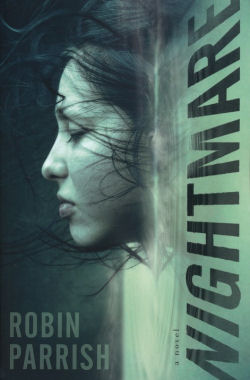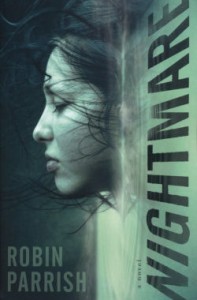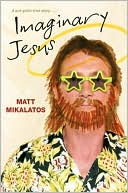by Jason Joyner | Jul 12, 2010 | Blog, CBA, christian fiction, Robin Parrish, speculative fiction
OK, not quite tomorrow. How about in a week?
In my last post I talked a little about Robin Parrish (Dominion Trilogy, Offworld) and his latest novel Nightmare. It was a featured book of the CFBA this week, and my copy has just arrived from Amazon. I haven’t started it, but I’ve heard not to read it too late at night.
It is being billed as a paranormal suspense. It deals with a girl whose parents were some of the country’s foremost ghost hunters. After a friend of hers disappears, she has to help the fiance find out what happened.
I’ve followed Robin for a long time, as he used to run a significant culture website called “Infuze” that examined the intersection of art and faith. I know that he loves the Lord. I also know that he has a particular taste in speculative fiction and is trying to explore some bigger ideas with his work. He was a big fan of Lost and I believe he uses that influence in his writing (never really watched it myself, so I can’t say for sure).
The point of this is, there were some reviews of Nightmare that questioned its place in the CBA realm of Christian fiction. (For the uninitiated, CBA is a term used to designate fiction written primarily for an evangelical Christian audience, usually through a store like Lifeway or Family Christian Bookstores. CBA is more precise here than saying “Christian fiction”).
It has been argued frequently and widely through the blogosphere on what constitutes Christian (CBA) fiction. Since I’ve been paying attention since around 2005, the tentpoles have increased significantly in just that time. The market is dominated by historical romance and Amish fiction, but includes quality suspense, chick lit, mystery, legal thrillers, and is starting to include more and more speculative fiction (such as science fiction and fantasy).
Having not read Nightmare yet, I’m a little limited in the claims I can make off of it right now. Still, is there room for CBA fiction to grow? Speculative fiction that encompasses more wide-ranging topics is very popular in mainstream culture (I’m quite interested in the upcoming moving Inception).
The CBA could move into other literary genres as well. My next post will talk about a new crime thriller, Back on Murder, that may also move boundaries some. Check back!
—
by Jason Joyner | Jul 12, 2010 | Blog, CBA, christian fiction, Robin Parrish, speculative fiction
OK, not quite tomorrow. How about in a week?
In my last post I talked a little about Robin Parrish (Dominion Trilogy, Offworld) and his latest novel Nightmare. It was a featured book of the CFBA this week, and my copy has just arrived from Amazon. I haven’t started it, but I’ve heard not to read it too late at night.
It is being billed as a paranormal suspense. It deals with a girl whose parents were some of the country’s foremost ghost hunters. After a friend of hers disappears, she has to help the fiance find out what happened.
I’ve followed Robin for a long time, as he used to run a significant culture website called “Infuze” that examined the intersection of art and faith. I know that he loves the Lord. I also know that he has a particular taste in speculative fiction and is trying to explore some bigger ideas with his work. He was a big fan of Lost and I believe he uses that influence in his writing (never really watched it myself, so I can’t say for sure).
The point of this is, there were some reviews of Nightmare that questioned its place in the CBA realm of Christian fiction. (For the uninitiated, CBA is a term used to designate fiction written primarily for an evangelical Christian audience, usually through a store like Lifeway or Family Christian Bookstores. CBA is more precise here than saying “Christian fiction”).
It has been argued frequently and widely through the blogosphere on what constitutes Christian (CBA) fiction. Since I’ve been paying attention since around 2005, the tentpoles have increased significantly in just that time. The market is dominated by historical romance and Amish fiction, but includes quality suspense, chick lit, mystery, legal thrillers, and is starting to include more and more speculative fiction (such as science fiction and fantasy).
Having not read Nightmare yet, I’m a little limited in the claims I can make off of it right now. Still, is there room for CBA fiction to grow? Speculative fiction that encompasses more wide-ranging topics is very popular in mainstream culture (I’m quite interested in the upcoming moving Inception).
The CBA could move into other literary genres as well. My next post will talk about a new crime thriller, Back on Murder, that may also move boundaries some. Check back!
—

by Jason Joyner | Jul 6, 2010 | Blog, books, Robin Parrish, speculative fiction

This week the CFBA is featuring
Nightmare by Robin Parrish. I didn’t sign up for this tour because I wanted to support Parrish by buying the book (the one downside of participating in the tour sometimes). The book is on its way, and I am looking forward to getting into his mind again.
Still, I want to add a little support to the CFBA tour. Robin provides some interesting thoughts for Christian (CBA) fiction. What are the boundaries of Christian fiction? What can this market accept? Mind you, I haven’t read Nightmare to give any opinions on its content, but I’ve seen a review on Amazon that questions its place in CBA fiction.
Let’s talk more about CBA’s boundaries tomorrow. In the meantime, if you would like to read the first chapter of
Nightmare, go
HERE.
—

by Jason Joyner | Jul 6, 2010 | Blog, books, Robin Parrish, speculative fiction

This week the CFBA is featuring
Nightmare by Robin Parrish. I didn’t sign up for this tour because I wanted to support Parrish by buying the book (the one downside of participating in the tour sometimes). The book is on its way, and I am looking forward to getting into his mind again.
Still, I want to add a little support to the CFBA tour. Robin provides some interesting thoughts for Christian (CBA) fiction. What are the boundaries of Christian fiction? What can this market accept? Mind you, I haven’t read Nightmare to give any opinions on its content, but I’ve seen a review on Amazon that questions its place in CBA fiction.
Let’s talk more about CBA’s boundaries tomorrow. In the meantime, if you would like to read the first chapter of
Nightmare, go
HERE.
—

by Jason Joyner | Jun 23, 2010 | Blog, CSFF, Imaginary Jesus, Jesus, speculative fiction
What, pray tell, is Imaginary Jesus?
First of all, you’ll have to check out my introductory post from yesterday. It is considered a novel by its publisher. It has a memoir-feel about it, if a memoir can have time travel and a talking donkey, along with a huge supporting cast of fake Jesuses.
I wonder a little bit how the Christian Sci-fi and Fantasy blog tour came to review it. It counts as “speculative” due to the bizarre unusual premise and the time travel aspect, I suppose. Suffice to say, it isn’t our usual fare of swords, magic, or space travel.
First, the writing. It is hard to discuss characters, as the main character is the author, Matt Mikalatos, and a plethora of Jesuses. Not your traditional novel in this aspect (I sense a theme here…). The writing is funny, quick to read, and generally quite clever. There is a patch toward the end that just gets frentic and confusing, but overall this book moves fast and fun. Again, it is a very non-traditional novel, but you can’t call it “creative non-fiction” either.
So, what about the message/theme/theology of a book that starts off with “Jesus” getting punched in the face? The whole premise is that Matt is confronted with the idea that the construct he believes is Jesus is an imaginary Jesus. This Jesus is a mash-up of ideas that makes Matt confortable. He feels chastened mildly by his Jesus, but usually this construct keeps him happy enough.
Matt has a visit by the apostle Peter who exposes this fraud, and the two chase off after the runaway Jesus. Matt is forced to confront this imaingary Jesus before he can meet the real Jesus. He takes a trip to the first century and gets a glipse of the Rabbi from Galilee. He then returns to modern day Portland, where he encounters many fake Jesuses (very creative here: Perpetually Angry Jesus, Testosterone Jesus [the Jesus of men’s retreats], and New Age Jesus are among the copies).
Finally, after confronting some tragedy in his own past, Matt pushes through all the distractions and cultural assumptions and meets the Master.
If one is to read this book, you have to realize that it is full of whimsy and satire. As someone else said in the tour, Matt never makes fun of Jesus – he is always highly respectful of the true Jesus. It distinguishes from the other Jesuses running around. It may be a little disconcerting seeing how he plays off of modern American church culture to construct these fakes, but if the reader keeps his eyes open, they should see the critique is on us Christians and how we all can create our own ideas of Jesus.
One could say it is the fun (and more theologically correct) version of The Shack. Sometimes the humor is thick enough to be distracting, but overall the message is potent. Is such humor appropriate to communicate a serious message? Mike Duran discussed this idea this week. I think the humor disarms us to allow the message to get past our defenses.
Final impressions: this is a book that takes chances. Hard to consider it a novel, but it doesn’t really fit anything else. It is an entertaining, quick read, especially if one has a sense of humor. There are some good challenges to how comfortable we get with our own Imaginary Jesuses, rather than fully seeking the Holy One of Israel, the King of Kings. George Barna even gets in on the action, having an appearance in the book and discussing our American habit of redefining Jesus.
Don’t let the back copy or cover scare you off. If you want a challenge to look at Jesus clearly, this book has a humorous poke at our sacred cows. And if you want other opinions from the CSFF crew, Becky Miller always keeps a running tab.
Special thanks to Tyndale House Publishers for supplying me with a review copy of Imaginary Jesus.
—

by Jason Joyner | Jun 23, 2010 | Blog, CSFF, Imaginary Jesus, Jesus, speculative fiction
What, pray tell, is Imaginary Jesus?
First of all, you’ll have to check out my introductory post from yesterday. It is considered a novel by its publisher. It has a memoir-feel about it, if a memoir can have time travel and a talking donkey, along with a huge supporting cast of fake Jesuses.
I wonder a little bit how the Christian Sci-fi and Fantasy blog tour came to review it. It counts as “speculative” due to the bizarre unusual premise and the time travel aspect, I suppose. Suffice to say, it isn’t our usual fare of swords, magic, or space travel.
First, the writing. It is hard to discuss characters, as the main character is the author, Matt Mikalatos, and a plethora of Jesuses. Not your traditional novel in this aspect (I sense a theme here…). The writing is funny, quick to read, and generally quite clever. There is a patch toward the end that just gets frentic and confusing, but overall this book moves fast and fun. Again, it is a very non-traditional novel, but you can’t call it “creative non-fiction” either.
So, what about the message/theme/theology of a book that starts off with “Jesus” getting punched in the face? The whole premise is that Matt is confronted with the idea that the construct he believes is Jesus is an imaginary Jesus. This Jesus is a mash-up of ideas that makes Matt confortable. He feels chastened mildly by his Jesus, but usually this construct keeps him happy enough.
Matt has a visit by the apostle Peter who exposes this fraud, and the two chase off after the runaway Jesus. Matt is forced to confront this imaingary Jesus before he can meet the real Jesus. He takes a trip to the first century and gets a glipse of the Rabbi from Galilee. He then returns to modern day Portland, where he encounters many fake Jesuses (very creative here: Perpetually Angry Jesus, Testosterone Jesus [the Jesus of men’s retreats], and New Age Jesus are among the copies).
Finally, after confronting some tragedy in his own past, Matt pushes through all the distractions and cultural assumptions and meets the Master.
If one is to read this book, you have to realize that it is full of whimsy and satire. As someone else said in the tour, Matt never makes fun of Jesus – he is always highly respectful of the true Jesus. It distinguishes from the other Jesuses running around. It may be a little disconcerting seeing how he plays off of modern American church culture to construct these fakes, but if the reader keeps his eyes open, they should see the critique is on us Christians and how we all can create our own ideas of Jesus.
One could say it is the fun (and more theologically correct) version of The Shack. Sometimes the humor is thick enough to be distracting, but overall the message is potent. Is such humor appropriate to communicate a serious message? Mike Duran discussed this idea this week. I think the humor disarms us to allow the message to get past our defenses.
Final impressions: this is a book that takes chances. Hard to consider it a novel, but it doesn’t really fit anything else. It is an entertaining, quick read, especially if one has a sense of humor. There are some good challenges to how comfortable we get with our own Imaginary Jesuses, rather than fully seeking the Holy One of Israel, the King of Kings. George Barna even gets in on the action, having an appearance in the book and discussing our American habit of redefining Jesus.
Don’t let the back copy or cover scare you off. If you want a challenge to look at Jesus clearly, this book has a humorous poke at our sacred cows. And if you want other opinions from the CSFF crew, Becky Miller always keeps a running tab.
Special thanks to Tyndale House Publishers for supplying me with a review copy of Imaginary Jesus.
—


